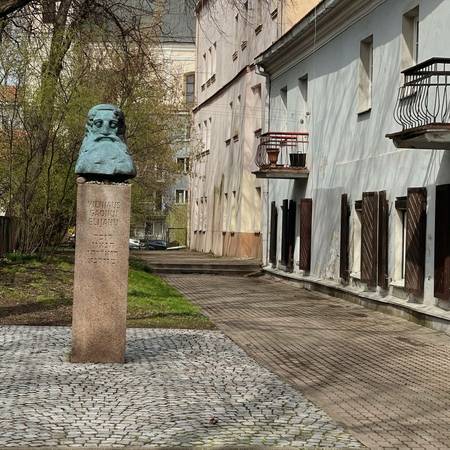One of the most vibrant areas of the city Žydų (Jewish) street is quiet today. The street had held its name even before the King of Poland and Grand Duke of Lithuania Wladyslaw Vasa in the 17th century granted the privilege to the Jews to reside in this quarter, so, likely, Jewish residents of Vilnius had already lived around here. A brick synagogue was allowed to be built in the quarter, later it became the famous Vilnius Great Synagogue. Before World War II, there were 135 synagogues in Vilnius.
On Fridays, everyone rushed to Žydų Street for the shopping. Here you could buy antiquities, visit a cobbler or a furrier. Shop signs announced that they sold kerosene for lamps, salt and cigarettes. A lot of different goods were sold in such department stores. They were popular not only among Jewish people but also Lithuanians. The latter often shopped here, as these skilful businessmen gave products and goods "on credit".
On Žydų street, once stood a house which didn’t survive - only a monument marks its place. Elijah Ben Solomon Zalman, better known as the Vilna Gaon, spent most of his life in that house. He was one of the most famous Jewish thinkers and scholars of all time.
The quarter, which has existed for more than 600 years and once occupied most of the current old town, was not only a place of Jewish residence, but also a town of goldsmiths, glassblowers, craftsmen and financiers. The goldsmiths' guild, the first GLD glass manufactory, was founded, and the quarter got its name after the establishment of a strong community, reminding of the times when there were even three Stiklo (Glass) streets here: the 1st, 2nd and 3rd. Stiklo street.
The so-called Glass Quarter is full of Jewish atmosphere and mood again, craftsmen flourish here, vibrant bustling prevails, and the buildings themselves help to preserve the aura of the quarter and honourable memory. The building with a rotunda at the beginning of Gaon Street is like a symbolic entrance to the quarter. Traces of Jewish culture can be found not only in the stories and names of streets, but also in the restaurant menus, jewellery symbols, and artworks in galleries. Even unique drawings - street art on the walls of the quarter - reproduce images of people from the 20th century - the photos of the Jewish Quarter.





Reviews